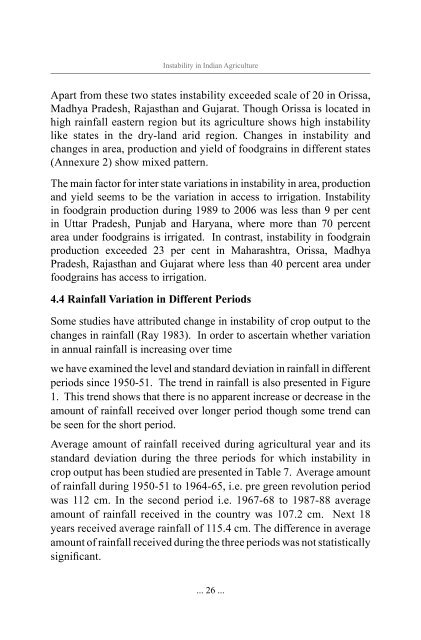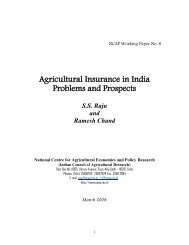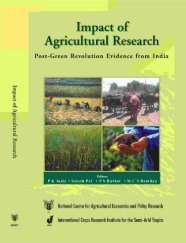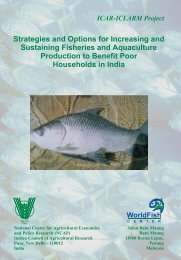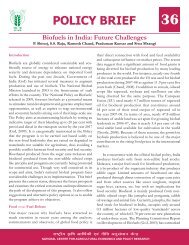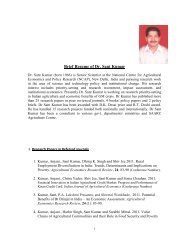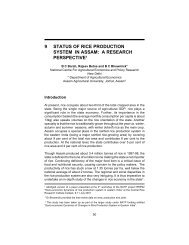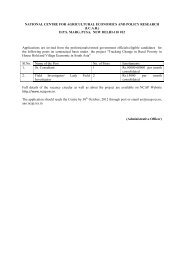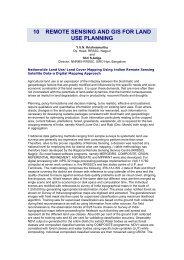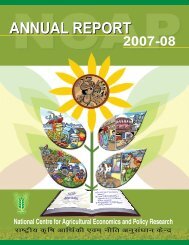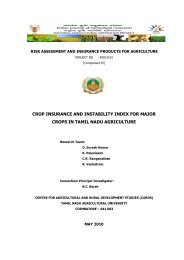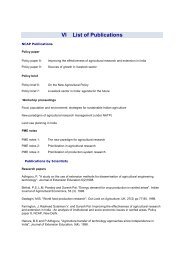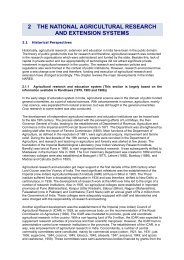Instability in Indian Agriculture - NCAP
Instability in Indian Agriculture - NCAP
Instability in Indian Agriculture - NCAP
You also want an ePaper? Increase the reach of your titles
YUMPU automatically turns print PDFs into web optimized ePapers that Google loves.
<strong>Instability</strong> <strong>in</strong> <strong>Indian</strong> <strong>Agriculture</strong><br />
Apart from these two states <strong>in</strong>stability exceeded scale of 20 <strong>in</strong> Orissa,<br />
Madhya Pradesh, Rajasthan and Gujarat. Though Orissa is located <strong>in</strong><br />
high ra<strong>in</strong>fall eastern region but its agriculture shows high <strong>in</strong>stability<br />
like states <strong>in</strong> the dry-land arid region. Changes <strong>in</strong> <strong>in</strong>stability and<br />
changes <strong>in</strong> area, production and yield of foodgra<strong>in</strong>s <strong>in</strong> different states<br />
(Annexure 2) show mixed pattern.<br />
The ma<strong>in</strong> factor for <strong>in</strong>ter state variations <strong>in</strong> <strong>in</strong>stability <strong>in</strong> area, production<br />
and yield seems to be the variation <strong>in</strong> access to irrigation. <strong>Instability</strong><br />
<strong>in</strong> foodgra<strong>in</strong> production dur<strong>in</strong>g 1989 to 2006 was less than 9 per cent<br />
<strong>in</strong> Uttar Pradesh, Punjab and Haryana, where more than 70 percent<br />
area under foodgra<strong>in</strong>s is irrigated. In contrast, <strong>in</strong>stability <strong>in</strong> foodgra<strong>in</strong><br />
production exceeded 23 per cent <strong>in</strong> Maharashtra, Orissa, Madhya<br />
Pradesh, Rajasthan and Gujarat where less than 40 percent area under<br />
foodgra<strong>in</strong>s has access to irrigation.<br />
4.4 Ra<strong>in</strong>fall Variation <strong>in</strong> Different Periods<br />
Some studies have attributed change <strong>in</strong> <strong>in</strong>stability of crop output to the<br />
changes <strong>in</strong> ra<strong>in</strong>fall (Ray 1983). In order to ascerta<strong>in</strong> whether variation<br />
<strong>in</strong> annual ra<strong>in</strong>fall is <strong>in</strong>creas<strong>in</strong>g over time<br />
we have exam<strong>in</strong>ed the level and standard deviation <strong>in</strong> ra<strong>in</strong>fall <strong>in</strong> different<br />
periods s<strong>in</strong>ce 1950-51. The trend <strong>in</strong> ra<strong>in</strong>fall is also presented <strong>in</strong> Figure<br />
1. This trend shows that there is no apparent <strong>in</strong>crease or decrease <strong>in</strong> the<br />
amount of ra<strong>in</strong>fall received over longer period though some trend can<br />
be seen for the short period.<br />
Average amount of ra<strong>in</strong>fall received dur<strong>in</strong>g agricultural year and its<br />
standard deviation dur<strong>in</strong>g the three periods for which <strong>in</strong>stability <strong>in</strong><br />
crop output has been studied are presented <strong>in</strong> Table 7. Average amount<br />
of ra<strong>in</strong>fall dur<strong>in</strong>g 1950-51 to 1964-65, i.e. pre green revolution period<br />
was 112 cm. In the second period i.e. 1967-68 to 1987-88 average<br />
amount of ra<strong>in</strong>fall received <strong>in</strong> the country was 107.2 cm. Next 18<br />
years received average ra<strong>in</strong>fall of 115.4 cm. The difference <strong>in</strong> average<br />
amount of ra<strong>in</strong>fall received dur<strong>in</strong>g the three periods was not statistically<br />
significant.<br />
... 26 ...


